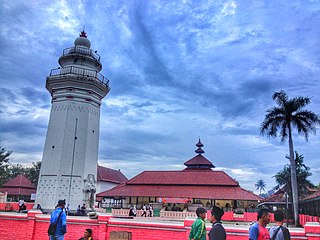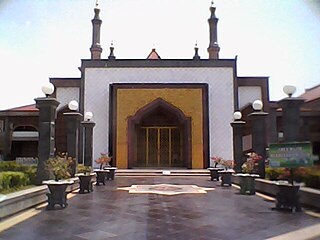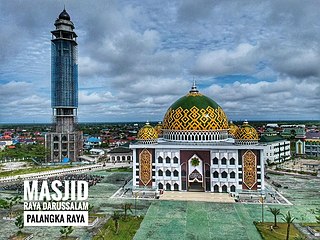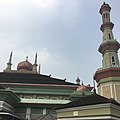
Istiqlal Mosque in Jakarta, Indonesia is the largest mosque in Southeast Asia and the ninth largest mosque in the world in terms of worshipper capacity. Built to commemorate Indonesian independence, this national mosque of Indonesia was named "Istiqlal", an Arabic word for "independence". The mosque was opened to the public on 22 February 1978. Within Jakarta, the mosque is positioned next to Merdeka Square and the Jakarta Cathedral (Catholic) and also of the Immanuel Church (Reformed).
Old Banten is an archaeological site in the northern coast of Serang Regency, Banten, Indonesia. Located 11 km north of Serang city, the site of Old Banten contains the ruin of the walled port city of Banten, the 16th-century capital of the Sultanate of Banten.

Serang is a city and the capital of Banten province and was formerly also the administrative center of Serang Regency in Indonesia. The city is located towards the north of Banten province, on the island of Java; the north part of the city contains the coast zone facing onto Banten Bay, and includes the historical site of Old Banten, after which the province is named. Before Banten province was formed in 2000, Serang city was part of West Java province.

The Great Mosque of Palembang, also known as Sultan Mahmud Badaruddin I Great Mosque after the former Sultan of Palembang, is the main mosque of Palembang, the capital of South Sumatra. The mosque is the largest in South Sumatra, and the third largest mosque in Sumatra after the Grand Mosque of West Sumatra and Great Mosque of Pekanbaru.

Kasunyatan Mosque is a small mosque in the village of Kasunyatan, Banten, Indonesia. Established between 1570 and 1596, it is one of the oldest mosques in Indonesia. The mosque is located in close proximity to the ruins of Old Banten, and functioned as a 16th-century centre of Islamic study. The mosque received a heritage status during the Dutch colonial period in 1932.

The Grand Mosque of Bandung, previously known as the Great Mosque of Bandung, is a mosque in Bandung, the provincial capital of West Java, Indonesia. The mosque received the status of provincial mosque of West Java Province in 2004. It is located on the east side of the alun-alun of Bandung.

Great Mosque of Banten is a historic mosque in Old Banten, 10 km north of Serang, Indonesia. The 16th-century mosque was one of the few surviving remnants of what used to be the port city of Banten, the most prosperous trading center in the Indonesian archipelago after the fall of Demak Sultanate in mid-16th century.

Al-Akbar National Mosque of Surabaya, also known as Al-Akbar Mosque or Great Mosque of Surabaya, is a national mosque located in Surabaya, East Java. It is the second largest mosque in Indonesia after Istiqlal Mosque in Jakarta in terms of maximum capacity. The location of the mosque is beside the Surabaya-Gempol Highway. Its most distinctive feature is its large vertical dome, accompanied by four small blue domes. It also has a minaret with height of 99 meters, an ode to the 99 Names of Allah.
Dian Al-Mahri Mosque, also known as Golden Dome Mosque(Masjid Kubah Emas), is a mosque built on the edge of Raya street, Depok City in West Java, Indonesia. In addition to being a place of worship for everyday Muslims, this mosque complex is also a tourist area for family and attracts many people because of its domes made of gold. Because of the vastness of area and accessibility to the public, this place is often a holiday destination for family or a place to take a rest.

Mosque architecture in Indonesia refers to the architectural traditions of mosques built in the archipelago of Indonesia. Initial forms of the mosque, for example, were predominantly built in the vernacular Indonesian architectural style mixed with Hindu, Buddhist or Chinese architectural elements, and notably didn't equip orthodox form of Islamic architectural elements such as dome and minaret. Vernacular architectural style varies depending on the island and region.

Al-Wustho Mangkunegaran Mosque is a historic mosque located in the Central Javanese city of Surakarta, to the west of the Mangkunegaran Palace. The mosque is one of the three oldest mosques of Surakarta. Al-Wustho Mangkunegaran Mosque was inaugurated as a state mosque of the Mangkunegaran Palace.

Grand Mosque of Kubang Putih is an early 19th-century mosque located in the town of Kubang Putiah, West Sumatra, Indonesia. The mosque is designated as a cultural heritage object along with several other old mosques in West Sumatra, such as Bingkudu Mosque in Agam, Rao Rao Mosque in Tanah Datar, and the Ganting Grand Mosque in Padang.

At-Taqwa Mosque or At-Taqwa Grand Mosque is a historical mosque in the city of Cirebon, West Java, founded in 1918. Today it is one of the congregational mosques in Cirebon and considered an icon of the city. The mosque also provides Islamic learning as well as public services such as blood donation and a free ambulance.

Al-Hilal Mosque or Al Hilal Old Mosque of Katangka, better known as Katangka Mosque, is a historical mosque in South Sulawesi, Indonesia. Constructed in 1603 by the first Muslim ruler of the Sultanate of Gowa, Sultan Alauddin, the mosque is considered the oldest mosque in South Sulawesi.

Ats-Tsauroh Great Mosque of Serang is a congregational mosque in the city of Serang, Banten, Indonesia. Founded in 1870, it is one of the oldest mosques in Banten province.

Al-Azhom Grand Mosque is a congregational mosque in the city of Tangerang, Banten, Indonesia. Opened in 2003, it is the largest mosque in Banten province and one of the largest mosques in the world in terms of the worshipper capacity.

Darussalam Grand Mosque, Palangka Raya is one of the mosques in Central Kalimantan. This grand mosque is located on George Obos Street in the district of Jekan Raya, Palangka Raya. This mosque is situated within the Islamic Center area of Palangka Raya. This grand mosque is also one of the most important icons of the capital city of Central Kalimantan province.

Al-Istiqlal Great Mosque, Murung Raya is the largest mosque in the entire Murung Raya Regency, Central Kalimantan, Indonesia. This great mosque is located on Jendral Sudirman Street, in the district of Murung, Murung Raya Regency. This great mosque is one of the most popular icons of Murung Raya Regency.

Al Jabbar Grand Mosque is a mosque located in Bandung, West Java, Indonesia. Due to the fact that it is around by a reservoir, the mosque is sometimes referred to as the Al Jabbar Floating Mosque. The mosque is situated in the Gedebage district in eastern Bandung.




























